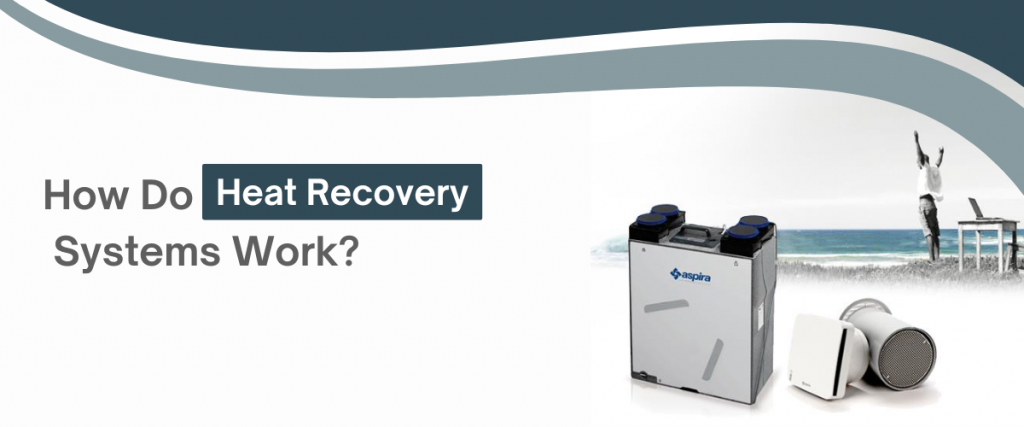Latest Blog
How Do Heat Recovery Systems Work?

The air you breathe at home or work matters. Keeping indoor spaces warm, comfortable, and full of fresh air helps people feel healthy and happy. Unfortunately, because most modern homes and offices are sealed tight to save energy, there are times when people will feel stuffy and experience bad air quality, adversely affecting their health. This is where a heat recovery system, also called HRV or MVHR, makes a big impact.
It works quietly in the background, replacing stale indoor air with clean outdoor air while saving the heat that you already paid for. These systems are now more important than ever for new buildings and busy family homes alike. If you are curious about breathing better, saving money on heating, and caring for the environment, a heat recovery system or a room ventilation system can offer an easy answer.
Understanding Heat Recovery Ventilation
A heat recovery system does two main things at once: it removes old, stale air from your house or building and brings in fresh air from outside. The clever part is that it does this in a way that keeps most of the warmth inside. The main part of the system is a heat exchanger.
Picture two separate airflow streams passing each other, like two trains on different tracks. Warm indoor air is taken out and passes by but does not mix with the cold fresh air coming in. The heat from the outgoing air moves through thin plates or tubes and warms up the incoming air before it enters your room. No actual air from outside touches the bad air from inside—only the heat passes over.
A heat recovery ventilator works whether you have a house, a shop, an office, or a school. It works on its own, separate from normal heating like boilers or radiators. It means the heat you have paid for is not wasted each time you open a window to let fresh air in.
The Components of a Heat Recovery System
Each heat recovery ventilation system has several key parts-
- Ducting: These are long pipes or channels that run through walls or ceilings. They guide the fresh air in and move stale air out.
- Air Valves: Small round vents that you may see in your ceiling or walls. They let air in and out of each room as needed.
- Central Ventilation Unit: This is the main box, usually in the attic or plant room. Inside are the heat exchanger, fans, and sometimes smart controls.
- Filters: These are essential for catching dust, pollen, and dirt. They keep the air clean and protect the system.
Together, these parts make sure air moves the right way, is filtered, and heat is saved before any air leaves the building.
The Air Exchange Cycle Explained
The air exchange cycle has two flows-
- Extract Air: Stale, damp air leaves places like kitchens, bathrooms, and utility rooms. This air is full of moisture and odours.
- Supply Air: At the same time, the system pulls in crisp air from outdoors, sending it to living rooms, bedrooms, or offices.
Inside the heat exchanger, the heat from the removed air passes to the fresh air, but the two never mix. This keeps the air clean, reduces the need for extra heating, and means germs or bad smells do not pass to other rooms.
Essential Benefits of Heat Recovery Ventilation

Clean air and warm rooms can be yours together, thanks to heat recovery ventilation. These systems look after your health, cut your energy bills, and protect the planet. They fit all sorts of buildings, from busy homes to open-plan offices.
Enhanced Indoor Air Quality and Health
Healthy air matters for everyone. A heat recovery system controls condensation and stops mould from forming on walls or windows. It takes away dust mites and other things that cause sneezing, itchy eyes, or breathing trouble. Fresh, filtered air enters every room each day, making it easier to sleep and work well.
Energy Efficiency and Lower Heating Costs
Heat recovery ventilation saves heat instead of throwing it out with the stale air. This means you spend less money heating your home or office. Some systems recover up to 95% of the wasted heat—that is, money back in your pocket every month. Over time, the system pays for itself with lower bills.
Creating a Comfortable and Quiet Environment
No one likes a stuffy or draughty room. An MVHR system helps every room feel just right—not too hot, not too cold. By keeping windows closed, you reduce outside noise, making it quieter for work, study, or sleep. The indoor air feels gentle and mild.
Environmental Benefits and Modern Innovations
When you save heat and energy, you also lower your carbon footprint. This helps our planet. Modern homes are built to be airtight, making heat recovery systems even more important.
Installation and Maintenance Considerations
It is easy to find the right fit for your home or building, whether you are building from scratch or updating an old place. You need to think about space, how air moves, and the best system for your needs. Professional help makes the setup smooth and sure.
Installation Options: New Build or Retrofit
If your house is brand new, putting in a heat recovery system is simple. The ducts and main unit can hide in the ceilings or walls as the house goes up. In older houses, retrofitting works too. Skilled installers route ducts with as little fuss as possible. Handy people can manage some simpler setups, but professional fitters guarantee the air goes where it should and the unit runs safely.
Routine Maintenance for Long-Term Performance
Keeping your system healthy does not take much. Change the filters a few times each year and check the main unit for dust. Some systems have lights or alarms to remind you when it is time. A clean, well-maintained system gives you the best air and saves the most energy.
The Bottom Line
A heat recovery system brings many rewards—warmth, fresh air, lower power bills, and peace of mind all in one. By taking the air you already have, cleaning it, and saving the heat, you make your home or business a better space for everyone.
Now is the time to explore your options. Read more about what makes these systems special, see what fits your building, and breathe easier with modern, efficient heat recovery ventilation.
Ready to Breathe Cleaner, Warmer Air? Let's Talk.
Fresh air and lower energy bills are just a step away. Ermen Systems is here to guide you through every part of choosing and installing a heat recovery system. No pressure—just honest advice and expert support. Get in touch with us or visit our website to learn more.
